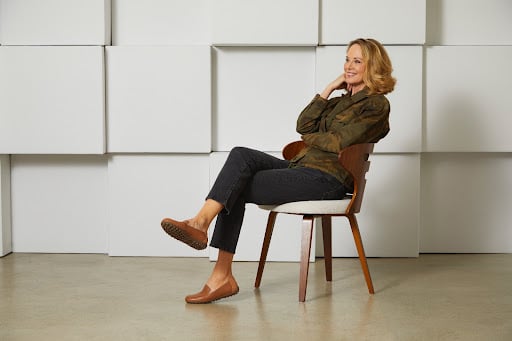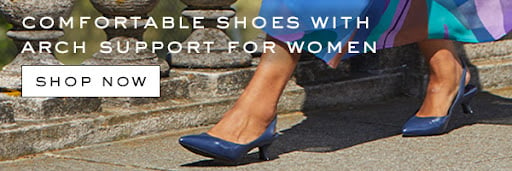When you think about it, most of us wear shoes for the majority of the day. If you sport a business-casual pair for work, switch them out for a pair of athletic shoes at the gym, and then slide into your slippers at home, that’s at least three pairs.
And, since the average person owns approximately 19 pairs of shoes,1 we’re willing to bet that you have more than three.
Can you imagine where we’d be without the practicality of shoes? Not only do they take us from place to place, but they also protect our feet and allow us to showcase our style preferences.
From past to present, join us as we journey back in time to learn about a brief history of shoes and discuss the good, the bad—and the strange—trends of years past.
When Did People Begin Wearing Shoes?
You’ve probably been wearing shoes as long as you can remember, but at what point did our ancestors come up with the idea of utilizing items found in nature to protect their feet?
A long, long time ago.
According to changes in humans’ toe strength and foot shape, our ancestors likely began using footwear with substantial soles approximately 40,000 years ago. However, they may have been wearing less sturdy shoes (albeit shoes, nonetheless) as far back as 50,000 years ago.2 Even makeshift shoes could have helped protect their feet from unfavorable conditions, like:
- Freezing snow
- Scalding hot sand
- Jagged rocks and brush
The earliest proof of footwear lies in a pair of sandals made from sagebrush bark that were found in the western part of the United States. These sandals date back to 7,000 to 8,000 BCE.3 While they may not have been as reliable or comfortable as the sandals you’re used to, they were likely sufficient at protecting the wearer’s feet from the threats of Mother Nature.
The Early Years: Shoes as Protection
When you arrive at the beach for a day of fun in the sun, you put on your hat, take off your shoes, and make your way onto that beautiful white sand—only to realize it’s burning your bare feet. At that point, you either make a mad dash for the cooling ocean water or put your sandals back on so you can casually find the perfect place to set up your beach umbrella and towels for the day.
Thousands of years ago, people had similar challenges. While they likely didn’t worry about where to unpack their towels and umbrellas, they definitely experienced discomfort when walking barefoot on hot sand. And although they may not have had a pair of manufactured flip-flops available to them, they did have all-natural materials like:
- Leaves
- Wood
- Leather hide from animals
With a dash of creativity and ingenuity, our ancestors were able to make shoes for a variety of environments to protect their feet from the elements.
For example, those in Ancient Egypt, who lived in a warm and dry environment, crafted open-toed sandals to keep themselves cool while simultaneously keeping their feet safe from debris and hot sand. In contrast, those in colder regions would do their best to make close-toed shoes called “foot bags” out of leather fabric to help keep their feet warm.4
Shoes as a Fashion Statement and Status Symbol
As the years wore on, shoes became more commonplace. Instead of using them simply to protect their feet, people would wear shoes as an accessory to their ensembles. Of course, not every civilization turned shoes into a status symbol at the same time.
Here’s a brief overview of how shoes in different locations around the world became a fashion statement and status symbol:
- In Egypt – As far back as 1200 BC, Egyptians wore shoes of various styles that determined the wearer’s place in society.4 For example, a commoner’s sandal consisted of a sole made of plaited hemp or papyrus and a simple leather strap. In contrast, sandals with a long piece of leather that curled around the top of the foot denoted a priest, king, or prince.
- In Rome – Like many other countries, the Romans used footwear to indicate their status in society. Commoners and slaves often wore very basic footwear while prisoners wore wooden shoes that intentionally made it more challenging and uncomfortable to walk. Upper-class citizens wore well-made sandals categorized by color to demonstrate the wearer’s ranking—senators would wear sandals with black thongs while emperors’ sandals were adorned with red ones.5
- In China – China is known for its ancient tradition of foot binding, which aims to make the average-sized foot much smaller and daintier (three inches in length was ideal).6 Girls would often take part in the practice, which involved breaking the bones in their toes and feet and binding them while they healed. Women who had their feet bound would often wear tiny pairs of silk embroidered slippers to demonstrate their petite size.
- In Europe – For hundreds of years, shoes have played a critical role in European fashion. In fact, the footwear you wore could make or break your status in society. Take the Crakow craze, for example. From medieval times to the 14th century, this trendy slipper-like shoe ended with the shoe’s toe pointed in an ostentatious upward curl (sometimes as large as 20 inches).7Then came the chopine, a very premature version of what we know as platform shoes. The height of the chopine was an indicator of a person’s wealth and status in society—the higher the shoe, the more power they had.
Shoes for the Masses
Making and buying shoes wasn’t always as easy as it is today. Settlers in the Americas couldn’t simply order a fresh pair of leather boots online. It was a much lengthier and more arduous process.
They had to procure the leather themselves, and then speak with a shoemaker to make a house call. While they were at a customer’s home, the shoemaker would complete the following steps to handcraft the client’s shoes:
- Step 1 – Measure the person’s feet.
- Step 2 – Cut the leather based on the aforementioned measurements.
- Step 3 – Sew the pieces together.
- Step 4 – Shape it into a shoe with a foot-shaped wooden block.
At the time, the block that shaped the shoes didn’t account for left or right feet. This meant that when your shoes were complete, you could (uncomfortably) wear them on either foot until the leather adjusted to your left and right foot. Thankfully, this changed in the 1800s when shoemakers began using blocks specifically made for each foot.8
As settlements in the Americas expanded, so did the need for shoes. It wasn’t until the Industrial Revolution that the first shoe factory appeared in Massachusetts in 1760.8 Eventually, shoemakers and factory workers began organizing themselves according to the task. Some apprentices focused on cutting leather, while others focused on sewing or other jobs. The expansion of factories greatly increased the number of shoes available to the masses.
Modern-Day Shoes: The 411 on Various Types of Footwear
The start of shoe factories eventually led to a wider variety of shoe style options. From sandals to sneakers, here are some of the contemporary footwear categories you’re familiar with (and a few historical fun facts related to each):
- Sandals – They’re light, they’re breathable, and they have one heck of a history. The word sandal comes from the Greek word “sandalon,” which means “wooden shoe”.9 They’re the oldest known type of footwear and have been worn by multiple cultures throughout the last millennium, including the Romans, Indians, Japanese, and many more who’ve all placed their own unique spin on this type of shoe.10
- Boots – The boots of yesteryear weren’t always the beautiful works of art you know and love today, but they did have one thing in common with contemporary boots—they were made to protect your feet. The original prototype of boots came to be around 1000 BC and consisted of leggings, soles, and uppers. Since then, they’ve progressed to various styles of boots, including knee-high boots, snow boots, riding boots, and high heel boots. What’s more, boots played an integral part in the history of high heels.
- Sneakers – Sneakers took a backseat to other shoe styles until their creation in 1830. They were originally used for walks on the beach and were known as “sand shoes”. In fact, the term sneaker didn’t come about until 1917 when Henry Nelson McKinney coined the word because the rubber soles made no sound and allowed the wearer to “sneak” from place to place.11
Find Your Next Historic Pair of Shoes at Vionic
Shoes have evolved immensely since the days of their conception. Now, you can buy shoes with the click of a button and have them delivered directly to your front door. Not to mention, you can easily find shoes that speak to your personal style and cater to your feet’s unique needs.
At Vionic, we offer a wide selection of supportive shoes in a variety of styles, from sandals to sneakers and beyond. Plus, with Vio-Motion™ technology built into every pair of shoes, you’ll notice better stabilization, ample cushioning, and optimum arch support no matter where the day takes you.
Make history, and add a pair of Vionic shoes to your collection today.
Sources:
- Lee, Wen. “#StuffCheck: How Many Shoes Do You Own?” New Dream. 1 March, 2013. https://newdream.org/blog/stuffcheck-shoes
- Shoe.”” Brittanica. https://www.britannica.com/topic/shoe
- “Shoe History, Types & Materials | When were Shoes First Made?” Study. https://study.com/academy/lesson/shoe-history-types-materials.html
- “The History of Your Shoes.” Shoe Info Net. https://shoeinfonet.com/shoe-history/history-your-shoes
- Morgan, Stuart. “Walking In the Footsteps of Ancient Rome.” Satra. https://www.satra.com/bulletin/article.php?id=2816
- Lim, Louisa. “Painful Memories for China’s Footbinding Survivors.” NPR. 19 March, 2017. https://www.npr.org/2007/03/19/8966942/painful-memories-for-chinas-footbinding-survivors
- Croizat-Glazer, Yassana. “Historical Shoe Trends, Sexual Constructs and the Need to Take Up Space.” A Women’s Thing. 15 July, 2021. https://awomensthing.org/blog/historical-shoe-trends-chopines-crakows/
- Fowler, Martha. “A foot at a time: Shoemaking played large in history of Rochester area.” Fosters. 8 May, 2009. https://www.fosters.com/story/business/2009/05/11/a-foot-at-time-shoemaking/52001853007/
- “Five Interesting Facts About Sandals.” Daily Journal. https://www.daily-journal.com/news/local/five-interesting-facts-about-sandals/article_176bcb3c-a7cf-11e8-b960-a7fa5e50f1fd.html
- Jana, Rosalind. “Everything to know about the history of sandals.” Vogue. 18 JUly, 2019. https://www.vogue.com.au/fashion/accessories/everything-to-know-about-the-history-of-sandals/image-gallery/161bc2fff5d3159b6dbc15f1dcf736cf
- “10 Interesting Facts About Shoes!” Trade Mart. 24 August 2021. https://www.trademart.be/en/inspiration/10-interesting-facts-about-shoes



Leave a Reply